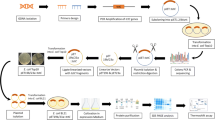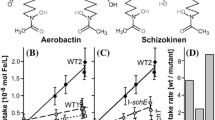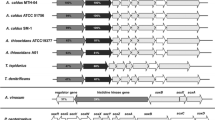Abstract
Desulfitobacterium hafniense strain Y51 dechlorinates tetrachloroethene to cis-1,2-dichloroethene (cis-DCE) via trichloroethene by the action of the PceA reductive dehalogenase encoded by pceA. The pceA gene constitutes a gene cluster with pceB, pceC, and pceT. However, the gene components, except for pceA, still remained to be characterized. In the present study, we characterized the function of PceT. PceT of strain Y51 showed a sequence homology with trigger factor proteins, although it is evolutionally distant from the well-characterized trigger factor protein of Escherichia coli. The PceT protein tagged with 6x histidine was expressed as a soluble form in E. coli. The recombinant PceT fusion protein exhibited peptidyl-proryl cis–trans isomerase activity toward the chromogenic peptide N-succinyl-Ala-Ala-Pro-Phe-p-nitroanilide. The PceT fusion protein also exhibited chaperon activity towards the chemically denatured citrate synthase. Immunoprecipitation analysis using antibodies raised against PceA and PceT demonstrated that PceT specifically binds to the precursor form of PceA with an N-terminal twin-arginine translocation (TAT) signal sequence. On the other hand, PceT failed to bind the mature form of PceA that lost the TAT signal sequence. This is the first report in dehalorespiring bacteria, indicating that PceT is responsible for the correct folding of the precursor PceA.





Similar content being viewed by others
References
Buchner J, Schmidt M, Fuchs M, Jaenicke R, Rudolph R, Schmid FX, Kiefhaber T (1991) GroE facilitates refolding of citrate synthase by suppressing aggregation. Biochemistry 30:1586–1591
Cuypers H, Viebrock-Sambale A, Zumft WG (1992) NosR, a membrane-bound regulatory component necessary for expression of nitrous oxide reductase in denitrifying Pseudomonas stutzeri. J Bacteriol 174:5332–5339
Damborsky J (1999) Tetrachloroethene-dehalogenating bacteria. Folia Microbiol 44:247–262
Furukawa K, Suyama A, Tsuboi Y, Futagami T, Goto M (2005) Biochemical and molecular characterization of a tetrachloroethene dechlorinating Desulfitobacterium sp. strain Y51: a review. J Ind Microbiol Biotechnol 32:534–541
Futagami T, Tsuboi Y, Suyama A, Goto M, Furukawa K (2006a) Emergence of two types of nondechlorinating variants in the tetrachloroethene-halorespiring Desulfitobacterium sp. strain Y51. Appl Microbiol Biotechnol 70:720–728
Futagami T, Yamaguchi T, Nakayama S, Goto M, Furukawa K (2006b) Effects of chloromethanes on growth of and deletion of the pce gene cluster in dehalorespiring Desulfitobacterium hafniense strain Y51. Appl Environ Microbiol 72:5998–6003
Guthrie B, Wickner W (1990) Trigger factor depletion or overproduction causes defective cell division but does not block protein export. J Bacteriol 172:5555–5562
Göthel SF, Schmid R, Wipat A, Carter NM, Emmerson PT, Harwood CR, Marahiel MA (1997) An internal FK506-binding domain is the catalytic core of the prolyl isomerase activity associated with the Bacillus subtilis trigger factor. Eur J Biochem 244:59–65
Hatzixanthis K, Clarke TA, Oubrie A, Richardson DJ, Turner RJ, Sargent F (2005) Signal peptide-chaperone interactions on the twin-arginine protein transport pathway. Proc Natl Acad Sci USA 102:8460–8465
Hesterkamp T, Deuerling E, Bukau B (1997) The amino-terminal 118 amino acids of Escherichia coli trigger factor constitute a domain that is necessary and sufficient for binding to ribosomes. J Biol Chem 272:21865–21871
Holliger C, Schumacher W (1994) Reductive dechlorination as a respiratory process. Antonie Leeuwenhoek 66:239–246
Holliger C, Wohlfarth G, Diekert G (1998) Reductive dechlorination in the energy metabolism of anaerobic bacteria. FEMS Microbiol Rev 22:383–398
Ilbert M, Méjean V, Giudici-Orticoni MT, Samama JP, Iobbi-Nivol C (2003) Involvement of a mate chaperone (TorD) in the maturation pathway of molybdoenzyme TorA. J Biol Chem 278:28787–28792
Lakshmipathy SK, Tomic S, Kaiser CM, Chang H-C H, Genevaux P, Georgopoulos C, Barral JM, Johnson AE, Hartl FU, Etchells SA (2007) Identification of nascent chain interaction sites on trigger factor. J Biol Chem 282:12186–12193
Lee PA, Tullman-Ercek D, Georgiou G (2006) The bacterial twin-arginine translocation pathway. Annu Rev Microbiol 60:373–395
Lyon WR, Gibson CM, Caparon MG (1998) A role for trigger factor and an rgg-like regulator in the transcription, secretion and processing of the cysteine proteinase of Streptococcus pyogenes. EMBO J 17:6263–6275
Löffler FE, Edwards EA (2006) Harnessing microbial activities for environmental cleanup. Curr Opin Biotechnol 117:274–284
Merz F, Hoffmann A, Rutkowska A, Zachmann-Brand B, Bukau B, Deuerling E (2006) The C-terminal domain of Escherichia coli trigger factor represents the central module of its chaperone activity. J Biol Chem 281:31963–31971
Mohn WW, Tiedje JM (1992) Microbial reductive dechlorination. Microbiol Rev 56:482–507
Nonaka H, Keresztes G, Shinoda Y, Ikenaga Y, Abe M, Naito K, Inatomi K, Furukawa K, Inui M, Yukawa H (2006) Complete genome sequence of the dehalorespiring bacterium Desulfitobacterium hafniense Y51 and comparison with Dehalococcoides ethenogenes 195. J Bacteriol 188:2262–2274
Saitou N, Nei M (1987) The neighbor-joining method: a new method for reconstructing phylogenetic tree. Mol Biol Evol 4:406–425
Scholz C, Schindler T, Dolinski K, Heitman J, Schmid FX (1997) Cyclophilin active site mutants have native prolyl isomerase activity with a protein substrate. FEBS Lett 414:69–73
Smidt H, Akkermans ADL, van der Oost J, de Vos WM (2000) Halorespiring bacteria-molecular characterization and detection. Enz Microbial Technol 27:812–820
Smidt H, de Vos WM (2004) Anaerobic microbial dehalogenation. Annu Rev Microbiol 58:43–73
Stoller G, Rücknagel KP, Nierhaus KH, Schmid FX, Fischer G, Rahfeld JU (1995) A ribosome-associated peptidyl-prolyl cis/trans isomerase identified as the trigger factor. EMBO J 114:4939–4948
Suyama A, Iwakiri R, Kai K, Tokunaga T, Sera N, Furukawa K (2001) Isolation and characterization of Desulfitobacterium sp. strain Y51 capable of efficient dechlorination of tetrachloroethene and polychloroethanes. Biosci Biotechnol Biochem 65:1474–1481
Suyama A, Yamashita M, Yoshino S, Furukawa K (2002) Molecular characterization of the PceA reductive dehalogenase of Desulfitobacterium sp. strain Y51. J Bacteriol 184:3419–3425
Tamura K, Dudley J, Nei M, Kumar S (2007) MEGA4: molecular evolutionary genetics analysis (MEGA) software version 4.0. Mol Biol Evol 24:1596–1599
Thompson JD, Higgins DG, Gibson TJ (1994) CLUSTAL W: improving the sensitivity of progressive multiple sequence alignment through sequence weighting, position-specific gap penalties and weight matrix choice. Nucleic Acids Res 22:4673–4680
Villemur R, Lanthier M, Beaudet R, Lépine F (2006) The Desulfitobacterium genus. FEMS Microbiol Rev 30:706–733
Wohlfarth G, Diekert G (1997) Anaerobic dehalogenases. Curr Opin Biotechnol 8:290–295
Wunsch P, Zumft WG (2005) Functional domains of NosR, a novel transmembrane iron-sulfur flavoprotein necessary for nitrous oxide respiration. J Bacteriol 187:1992–2001
Acknowledgments
We thank Drs. Shinya Sugimoto, Fuminori Yoneyama, and Kenji Sonomoto for light-scattering analysis. This work was supported in part by a Grant-in-aid (Hazardous Chemicals) from the Ministry of Agriculture, Forestry, and Fisheries of Japan (HC-04-2321-1).
Author information
Authors and Affiliations
Corresponding author
Rights and permissions
About this article
Cite this article
Morita, Y., Futagami, T., Goto, M. et al. Functional characterization of the trigger factor protein PceT of tetrachloroethene-dechlorinating Desulfitobacterium hafniense Y51. Appl Microbiol Biotechnol 83, 775–781 (2009). https://doi.org/10.1007/s00253-009-1958-z
Received:
Revised:
Accepted:
Published:
Issue Date:
DOI: https://doi.org/10.1007/s00253-009-1958-z




